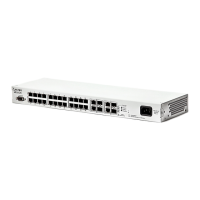12 MES1000, MES2000 Ethernet Switches
received and sent by the switch.
Port mirroring allows to duplicate the traffic for monitored ports, sending inbound
and/or outbound packets to the controlling port. Switch users can define
controlled and controlling ports and select the type of traffic (inbound or
outbound), that will be sent to the controlling port.
This function allows to assign the uplink port to the switch port. This uplink port
will receive all the traffic and provide isolation from other ports (in a single
switch).
This function allows to isolate the group of ports (in a single switch), located in the
same broadcast domain, from each other, allowing traffic exchange with other
ports, located in the same broadcast domain, but not belonging to this group.
Provides isolation of devices, located in the same broadcast domain, within L2
network. Only two port operation modes are implemented—Promiscuous and
Isolated (isolated ports cannot exchange traffic).
Spanning Tree Protocol is a network protocol that ensures loop-free network
topology by converting networks with redundant links to the tree-like structure.
Switches exchange configuration messages, using the special format frames, and
selectively enable or disable device ports.
IEEE 802.1w Rapid
spanning tree protocol
Rapid STP (RSTP) is the enhanced version of STP protocol that enables faster
network conversion to the tree-like topology and provides higher stability.
EAPS (Ethernet Automatic Protection Switching) is a protocol, that allows to avoid
traffic loops in the ring topology networks and enables fast restoration of traffic
flow after the failure in the specific network section. Restoration time provided by
EAPS is far less than in case of spanning tree protocols.
Ethernet Ring Protection
Switching
The protocol allows to increase stability and robustness of data network
with ring topology by decreasing the restoration time after the failure.
Restoration time does not exceed 1 second, that is substantially lower than
the network reconstruction in case of Spanning Tree family protocols.
GVRP VLAN registration protocol enables dynamic adding/removal of VLAN groups
on the switch ports. If GVRP protocol is enabled, the switch identifies and then
distributes the VLAN inherence data to all ports, that form the active topology.
Distribution to VLAN groups is performed by the inbound ports. This solution
allows to use only one VLAN group on each port.
IEEE 802.1Q is an open standard, that describes the traffic tagging procedure for
transfer of VLAN inherence information. It allows to use multiple VLAN groups on
one port.
Link aggregation (LAG
link groups)
Devices support link group creation functions. Link aggregation, trunking or IEEE
802.3ad is the technology, that enables aggregation of multiple physical links into
one logical link. This technology allows to increase the bandwidth and reliability of
the backbone 'switch-switch' or 'switch-server' channels. There are three types of
balancing between channels: based on MAC addresses, IP addresses and the
destination port.
LAG group contains similar speed ports, operating in full-duplex mode.
Dynamic link groups
(LACP protocol)
LACP protocol enables automatic aggregation of separate links between two
devices (switch-switch or switch-server) in a single data communication channel.
Protocol constantly tries to find ways for link aggregation; in case of link failure in
the aggregated channel, its traffic will be automatically redistributed to

